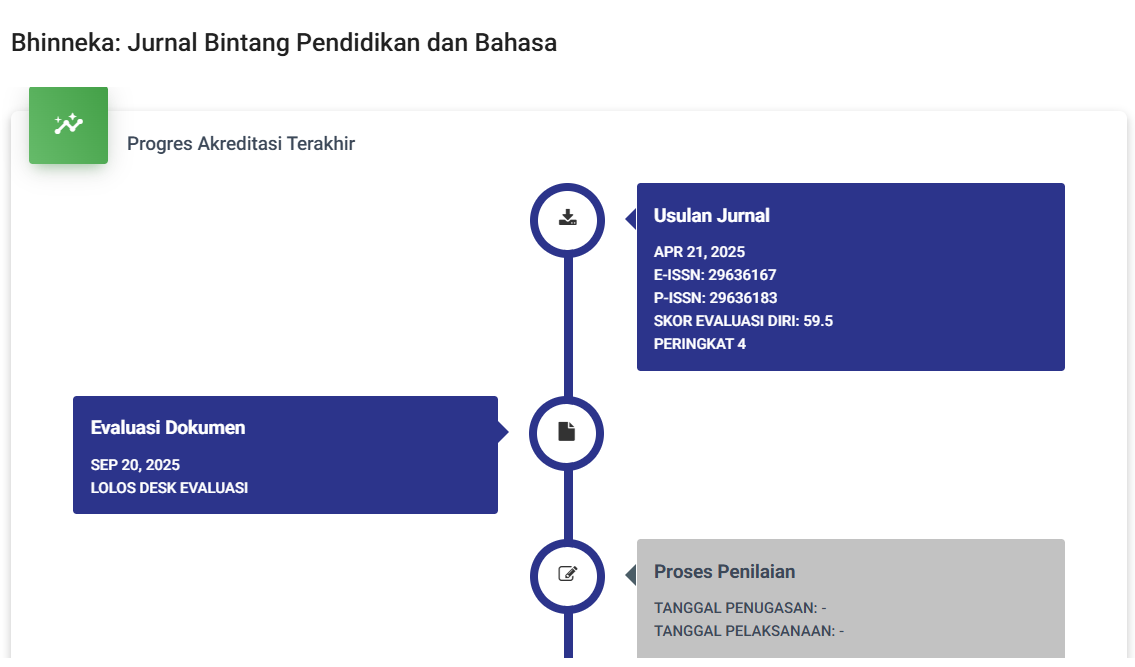Analisis Semiotika Puisi “Kesabaran” Karya Chairil Anwar
DOI:
https://doi.org/10.59024/bhinneka.v1i3.186Keywords:
Literature, Semiotics, Poetry, PatienceAbstract
Literary work is a creation that is conveyed by speaking or communicative about the author's intention which aims for aesthetics. One example of a literary work is poetry, poetry is a type of literary work that has beautiful, animating, and deep meanings and meanings, the words and sentences contained in it mostly come from the heart of the creator of the poem, when reading it you also have to use a good intonation. clear, and expressions that match the content of the poem. This study aims to semiotically analyze the poem entitled "Patience" by Chairil Anwar. This poem describes the patience of a poet or poet who always faces people who are near him and around him, even though he always feels uncomfortable with the environment. and always feel annoyed by the people around him, but he realizes that this is what is called fate and life, in the first stanza describes noise so that the poet feels uncomfortable and very disturbed by the sounds around him, not only is it ridicule and insults were heard and thrown from one person to another. In this world, only a few are filled with goodness, and badness is increasingly rampant, even though many have warned and rebuked, but the reprimands and warnings were only a passing wind, and were not paid any heed to by the parties concerned. The second stanza describes something that the poet wants to convey, but the idea is not heard at all, they seem to regard the writer as if the wind were passing by, the third stanza describes a state of life that has lost its calm and serenity, so that life is worthy very hard to reach. The last stanza describes the condition of the poet who is no longer respected and heard by those around him so that the poet no longer cares about it. At this time, the poet hopes that calm and tranquility will return, so that a decent life can be created again.
References
Aminuddin. (1991). Pengantar Apresiasi Karya Sastra. Bandung: Sinar Harapan.
Burchardt. (1984). Mengenal Ajaran Kaum Sufi. Jakarta: Pustaka Jaya.
Hikmat, Ade, Nur Aini Puspitasari, & Syarif Hidayatullah. (2017). Kajian Puisi. Jakarta: FKIP UHAMKA.
Isnaini, H. (2022c). Suwung dan Metafora Ketuhanan pada Puisi "Dalam Diriku" Karya Sapardi Djoko Damono. Jurnal Telaga Bahasa: Balai Bahasa Gorontalo, Volume 10, Nomor 1, 22-31.
Isnaini, H. (2023). Semesta Sastra (Studi Ilmu Sastra): Pengantar Teori, Sejarah, dan Kritik. Bandung: CV Pustaka Humaniora.
Mayer dan Greenwood. (1983). Rancangan Penelitian Kebijakan Sosial. Jakarta: Rajawali.
Mimin, Wikanengsih, & Permana, Aditya. (2022). Analisis Makna Diksi lirik lagu “Satu” milik Dewa 19 dengan menggunakan Pendekatan Semiotik, 5(4), 279. Parole: Jurnal Pendidikan Bahasa dan Sastra Indonesia.
Pradopo, Rachmat Djoko. (2013). Pengkajian Puisi. Yogyakarta: Gadjah Mada University Press.
Rahayu, Ika Sari. (2021). Analisis Kajian Semiotika dalam Puisi Chairil Anwar menggunakan Teori Charles Sanders Peirce, 15(1), 32. Yogyakarta: FBS Universitas Negeri Yogyakarta.
Sobur, A. (2017). Semiotika Komunikasi, Cetakan ke-5. PT Remaja Rosdakarya Offset.
Sugiyono. (2016). Metode Penelitian Kuantitatif, Kualitatif dan R&D, Cetakan ke-24. Bandung: PT Alfabeta.
Suherdiana, Dadan. (2008). Konsep Dasar Semiotik dalam Komunikasi Massa menurut Charles Sanders Pierce, 4(12), 375. Bandung: UIN Bandung.
Sumardjo, Jakob. (2001). Memahami Kesusastraan. Bandung: Alumni 2001.








